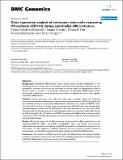| dc.contributor.author | Nikolova-Krstevski, Vesna | |
| dc.contributor.author | Bhasin, Manoj | |
| dc.contributor.author | Otu, Hasan H | |
| dc.contributor.author | Libermann, Towia Aron | |
| dc.contributor.author | Oettgen, Peter | |
| dc.date.accessioned | 2010-12-08T20:55:16Z | |
| dc.date.issued | 2008 | |
| dc.identifier.citation | Nikolova-Krstevski, Vesna, Manoj Bhasin, Hasan H. Otu, Towia Libermann, and Peter Oettgen. 2008. Gene expression analysis of embryonic stem cells expressing VE-cadherin (CD144) during endothelial differentiation. BMC Genomics 9:240. | en_US |
| dc.identifier.issn | 1471-2164 | en_US |
| dc.identifier.uri | http://nrs.harvard.edu/urn-3:HUL.InstRepos:4621166 | |
| dc.description.abstract | Backgroun: Endothelial differentiation occurs during normal vascular development in the developing embryo. This process is recapitulated in the adult when endothelial progenitor cells are generated in the bone marrow and can contribute to vascular repair or angiogenesis at sites of vascular injury or ischemia. The molecular mechanisms of endothelial differentiation remain incompletely understood. Novel approaches are needed to identify the factors that regulate endothelial differentiation. Methods: Mouse embryonic stem (ES) cells were used to further define the molecular mechanisms of endothelial differentiation. By flow cytometry a population of VEGF-R2 positive cells was identified as early as 2.5 days after differentiation of ES cells, and a subset of VEGF-R2+ cells, that were CD41 positive at 3.5 days. A separate population of VEGF-R2+ stem cells expressing the endothelial-specific marker CD144 (VE-cadherin) was also identified at this same time point. Channels lined by VE-cadherin positive cells developed within the embryoid bodies (EBs) formed by differentiating ES cells. VE-cadherin and CD41 expressing cells differentiate in close proximity to each other within the EBs, supporting the concept of a common origin for cells of hematopoietic and endothelial lineages. Results: Microarray analysis of > 45,000 transcripts was performed on RNA obtained from cells expressing VEGF-R2+, CD41+, and CD144+ and VEGF-R2-, CD41-, and CD144-. All microarray experiments were performed in duplicate using RNA obtained from independent experiments, for each subset of cells. Expression profiling confirmed the role of several genes involved in hematopoiesis, and identified several putative genes involved in endothelial differentiation. Conclusion: The isolation of CD144+ cells during ES cell differentiation from embryoid bodies provides an excellent model system and method for identifying genes that are expressed during endothelial differentiation and that are distinct from hematopoiesis. | en_US |
| dc.language.iso | en_US | en_US |
| dc.publisher | BioMed Central | en_US |
| dc.relation.isversionof | doi: 10.1186/1471-2164-9-240 | en_US |
| dc.relation.hasversion | http://www.ncbi.nlm.nih.gov/pmc/articles/PMC2440556/pdf/ | en_US |
| dash.license | LAA | |
| dc.title | Gene Expression Analysis of Embryonic Stem Cells Expressing VE-Cadherin (CD144) During Endothelial Differentiation | en_US |
| dc.type | Journal Article | en_US |
| dc.description.version | Version of Record | en_US |
| dc.relation.journal | BMC Genomics | en_US |
| dash.depositing.author | Otu, Hasan H | |
| dc.date.available | 2010-12-08T20:55:16Z | |
| dash.affiliation.other | HMS^Medicine- Beth Israel-Deaconess | en_US |
| dash.affiliation.other | HMS^Medicine- Beth Israel-Deaconess | en_US |
| dc.identifier.doi | 10.1186/1471-2164-9-240 | * |
| dash.contributor.affiliated | Otu, Hasan H | |
| dash.contributor.affiliated | Libermann, Towia | |


